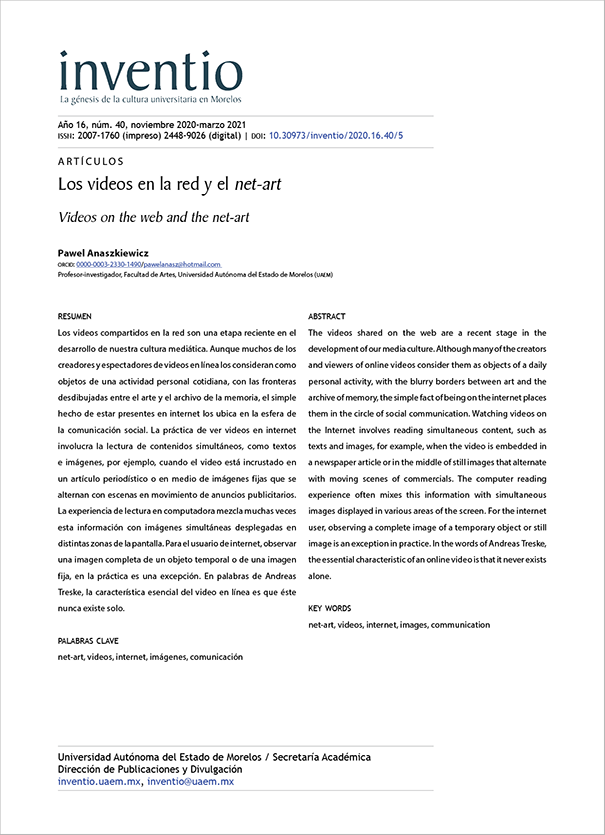Los videos en la red y el net-art
Videos on the web and the net-art
DOI:
https://doi.org/10.30973/inventio/2020.16.40/5Palabras clave:
net-art, videos, internet, imágenes, comunicaciónResumen
Los videos compartidos en la red son una etapa reciente en el desarrollo de nuestra cultura mediática. Aunque muchos de los creadores y espectadores de videos en línea los consideran como objetos de una actividad personal cotidiana, con las fronteras desdibujadas entre el arte y el archivo de la memoria, el simple hecho de estar presentes en internet los ubica en la esfera de la comunicación social. La práctica de ver videos en internet involucra la lectura de contenidos simultáneos, como textos e imágenes, por ejemplo, cuando el video está incrustado en un artículo periodístico o en medio de imágenes fijas que se alternan con escenas en movimiento de anuncios publicitarios. La experiencia de lectura en computadora mezcla muchas veces esta información con imágenes simultáneas desplegadas en distintas zonas de la pantalla. Para el usuario de internet, observar una imagen completa de un objeto temporal o de una imagen fija, en la práctica es una excepción. En palabras de Andreas Treske, la característica esencial del video en línea es que éste nunca existe solo.
The videos shared on the web are a recent stage in the development of our media culture. Although many of the creators and viewers of online videos consider them as objects of a daily personal activity, with the blurry borders between art and the archive of memory, the simple fact of being on the internet places them in the circle of social communication. Watching videos on the Internet involves reading simultaneous content, such as texts and images, for example, when the video is embedded in a newspaper article or in the middle of still images that alternate with moving scenes of commercials. The computer reading experience often mixes this information with simultaneous images displayed in various areas of the screen. For the internet user, observing a complete image of a temporary object or still image is in practice, an exception. In the words of Andreas Treske, the essential characteristic of an online video is that it never exists alone.
Citas
Abad, A. (25 de julio de 2014). Megafone.net/2004-2014/. https://www.youtube.com/watch?v=nlepNcjbOj4
Abbate, J. (2000). Inventing the Internet. Cambridge: Massachusetts Institute of Technology.
Berry, T. (2014). The Film of Tomorrow: A cultural History of Videoblogging. [Tesis doctoral, Universidad de Sussex].
Bishop, C. (2012). Digital Divide: Contemporary Art and New Media. Artforum. https://www.artforum.com/print/201207/digital-divide-contemporary-art-and-new-media-31944
Brea, J. L. (2004). El tercer umbral. Estatuto de las prácticas artísticas en la era de capitalismo cultural. Cendeac.
Chatonsky, G. (2007). Flux: entre fiction et narration. http://chatonsky.net/flux-entre-fiction-et-narration/
Chatonsky, G. (2008). Dance with US. http://chatonsky.net/dance-with-us/
Chatonsky, G. (2009). Flussgeist: The Spirit of the Network [Flussgeist: El espíritu de la red]. http://chatonsky.net/flussgeist/
Chatonsky, G. (2015). Netsea. http://chatonsky.net/netsea/
Fonsi, L. (12 de enero de 2017). Luis Fonsi - Despacito ft. Daddy Yankee [Captura de pantalla]. Youtube. https://www.youtube.com/watch?v=kJQP7kiw5Fk
Internet World Stats Usage and Population Statistics (30 de septiembre de 2020). Internet Users Distribution in the World-2020 Q3. https://www.internetworldstats.com/stats.htm
Manovich, L. (2008). The Practice of Every (Media) Life. En Lovink, G. y Niederer, S. (eds.), Video Vortex Reader, Responses to YouTube. Institute for Networked Cultures (pp. 33-43).
Mohsin, M. (5 de febrero de 2020). Estadísticas youtube 2021 [infografía]-10 datos fascinantes de youtube. Oberlo. https://www.oberlo.com.mx/blog/estadisticas-youtube
Osman, M. (6 de septiembre de 2019). Estadísticas y datos impresionantes del YouTube (El segundo sitio más visitado). Kinsta. https://kinsta.com/es/blog/estadisticas-youtube/
Stiegler, B. (2002). La técnica y el tiempo II. La desorientación. Hiru Argitaletxea.
Stiegler, B. (2004). La técnica y el tiempo III. El tiempo del cine y la cuestión del malestar. Hiru Argitaletxea.
Treske, A. (2013). The Inner Life of Video Spheres. Institute of Network Cultures.
Vanderbeeken, R. (2011). Web Video and the Screen as a Mediator and Generator of Reality. En Lovink, G. y Miles, S. R. (eds.), Video Vortex Reader II: Moving Images Beyond YouTube. Institute of Network Cultures (p. 36).
Waelder, P. (2010). The Constant Murmur of Data. M/C Journal, 13 (2). https://doi.org/10.5204/mcj.228
Waelder, P. (30 de marzo de 2011). El flujo de datos, una ficción en la red. Arte y cultura digital. http://laboralcentrodearte.uoc.edu/?p=1567

Publicado
Cómo citar
Número
Sección
Licencia
Derechos de autor 2021 Pawel Anaszkiewicz

Esta obra está bajo una licencia internacional Creative Commons Atribución-NoComercial 4.0.
Esta revista proporciona acceso abierto inmediato a su contenido, con base en el principio de ofrecer al público un acceso libre a las investigaciones para contribuir a un mayor intercambio global de conocimientos. Se distribuye bajo una licencia Creative Commons Reconocimiento-NoComercial 4.0 Internacional License.

